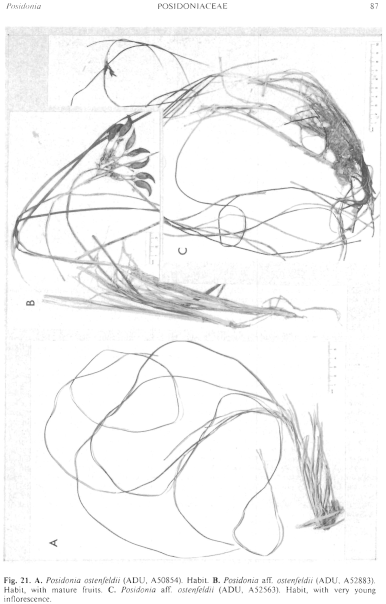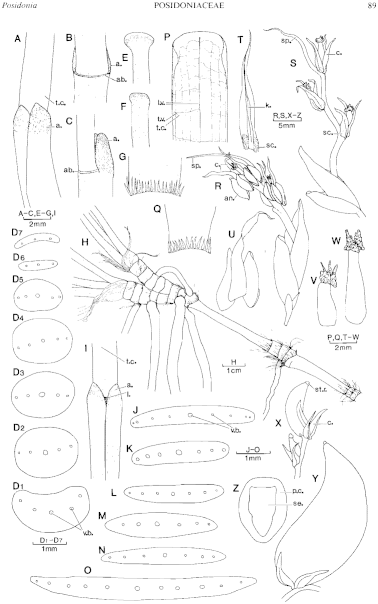|
|
|
|
|
|||||||||||
|
Electronic Flora of South Australia Species Fact Sheet
Phylum Magnoliophyta – Subphylum Seagrasses – Class Liliopsida – Subclass Alismatidae – Order Potamogetonales – Family Posidoniaceae
Selected citations: Aston 1973: 270 (in part). Green 1981: 5. Jessop 1978: 77 (in part).
Robust rhizomatous perennial herb (Fig. 21A). Rhizomes 1–3 mm thick, oval in cross section, with long internodes 2–3 cm long separated by a series of several short internodes 0.5–3 mm long. Roots arising irregularly, 1–2 per node, pale-brown in colour, coarse, 1–2.5 mm in diameter, becoming wrinkled and hollow with age. Leaves (1–) 2 (–3) per shoot; sheath (Fig. 22A) 12–18 cm long, margins overlapping for their entire length; ligule about 1 mm long; auricles (Fig. 22B, C) 2–2.5 mm long, 2–3 mm wide, dark-brown; after fall of the blade the sheath gradually disintegrates into numerous pale hair-like fibres; blade (Fig. 22D) (40–) 60–135 cm long, terete and 1–1.5 mm in diameter near the base, becoming somewhat flattened (biconvex in cross section) and gradually tapering higher up (when dry, biconvex in cross section throughout except near the base which remains terete), longitudinal vascular bundles 5; apex (Fig. 22E, F) flattened, spathulate. Squamules (Fig. 22G) linear-lanceolate, 0.5–1.4 mm long. Inflorescence borne on a flattened peduncle 30–35 cm long, considerably shorter than the leaf-canopy; subtending bracts 2, unequal, the longer bract about 20 cm in length greatly exceeding the spikes; spikes 3–7, each terminating in a spur about 4 mm long. Flowers bisexual, 3–4 per spike. Fruit 2–4 cm long, ovate with a recurved tip.
Type from Esperance Bay, W. Aust. (J. Firman, Dec. 1951); in AD, 96404336.
Selected specimens: The type and Bremer Bay, W. Aust., 10 m deep (Cambridge, 28.xi.1979; ADU, A50854).
Distribution: From Cape Leeuwin to Israelite Bay, W. Aust. P. ostenfeldii grows in areas of strong wave action usually below 10 m deep.
Taxonomic notes: P. ostenfeldii is known mostly from sterile drift material; floral parts when present are frequently damaged.
References:
ASTON, H. (1973). Aquatic plants of Australia. (Melbourne University Press: Melbourne.)
DEN HARTOG, C. (1970). The seagrasses of the World. Verh. k. ned. Akad. Wet. Afd. Natuurk., ser. 2, 59(1), 1–275 (-1–31 Plates).
GREEN, J.W. (1981). Census of the Vascular Plants of Western Australia. (Western Australian Herbarium: South Perth.)
JESSOP, J.P. (1978). J.M. Black's Flora of South Australia. 3rd edn. Part I. (Govt. Printer: Adelaide.)
The Marine Benthic Flora of Southern Australia Part I complete list of references.
Publication:
Womersley, H.B.S. (31 May, 1984)
The Marine Benthic Flora of Southern Australia
Part I
©Board of the Botanic Gardens and State Herbarium, Government of South Australia
Illustrations in Womersley Part I, 1984: FIGS 21A, 22 A–G.

Figure 21 enlarge
Fig. 21. A. Posidonia ostenfeldii (ADU, A50854). Habit. B. Posidonia aff. ostenfeldii (ADU, A52883). Habit, with mature fruits. C. Posidonia aff. ostenfeldii (ADU, A52563). Habit, with very young inflorescence.

Figure 22 enlarge
Fig. 22. A–G. Posidonia ostenfeldii (ADU, A50854). A. Portion of leaf (adaxial view). Junction of blade and sheath showing overlapping margins, auricles (a.) with accumulation of tannin cells (t.c.), and position of transverse veins marked by lines of tannin cells. B. Portion of leaf (abaxial view). Junction of blade and sheath showing the abscission line (ab.) and auricles (a.). C. Portion of leaf (side view). Junction of blade and sheath showing abscission line (ab.) and auricles (a.). D1-D7. T.S. leaf blade at 7 levels showing row of longitudinal vascular bundles (v.b.). D1. 5 mm above ligule. D2. 15 cm above ligule. D3.30 cm above ligule. D4.60 cm above ligule. D5.110 cm above ligule. D6.120 cm above ligule. D7. 130 cm above ligule or 5 mm from apex. E. Apex of juvenile leaf (adaxial view). F. Apex of mature leaf (adaxial view). G. Squamules adhering to base of leaf sheath.
H–Z. Posidonia aff. ostenfeldii H. Portion of rhizome showing long internodes alternating with a series of short internodes, and the fibrous remains of sheaths at each node. I. Portion of leaf (adaxial view). Junction of blade and sheath showing overlapping margins, ligule (l.), auricles (a.) (with accumulation of tannin cells) and position of transverse vein marked by lines of tannin cells (t.c.) J-0. T.S. mid portion of leaf blade showing row of longitudinal vascular bundles (v.b.) (from 6 separate collections). P. Leaf apex (abaxial view) showing recurved margins, longitudinal veins (1.v.), transverse veins (t.v.) and tannin cells (t.c.). Q. Squamules adhering to base of leaf sheath. R. Portion of inflorescence showing spike of 2 flowers with dehisced anthers (an.). S. Portion of inflorescence showing spike of 3 flowers after anthers have fallen. Note scars (sc.) on persistent connective (c.), and terminal spur (sp.). T. Connective (abaxial view) with keel (k.) after anthers have fallen. Note scars (sc.). U. Stamen (adaxial view) showing connective and anthers. V. Ovary and lobed stigma. W. Ovary (after fertilisation) and persistent lobed stigma. X. Spike of 2 young fruits showing persistent connectives (c.) and stigma remnant (st.r.) Y. Mature fruit. Z. T.S. fruit showing pericarp (p.c.) and seed (se.) (H, I, L from ADU, A52563. J from ADU, A51381. K from ADU, A46461. M from ADU, A53639. N from ADU, A52883. O–Q from ADU, A51942. R, T–V from ADU, A46464. S, W from ADU, A52748. X–Z from ADU, A48914.)

|
Email Contact: State Herbarium of South Australia |

|